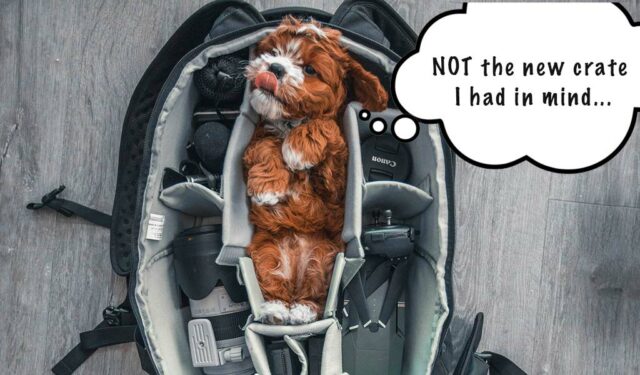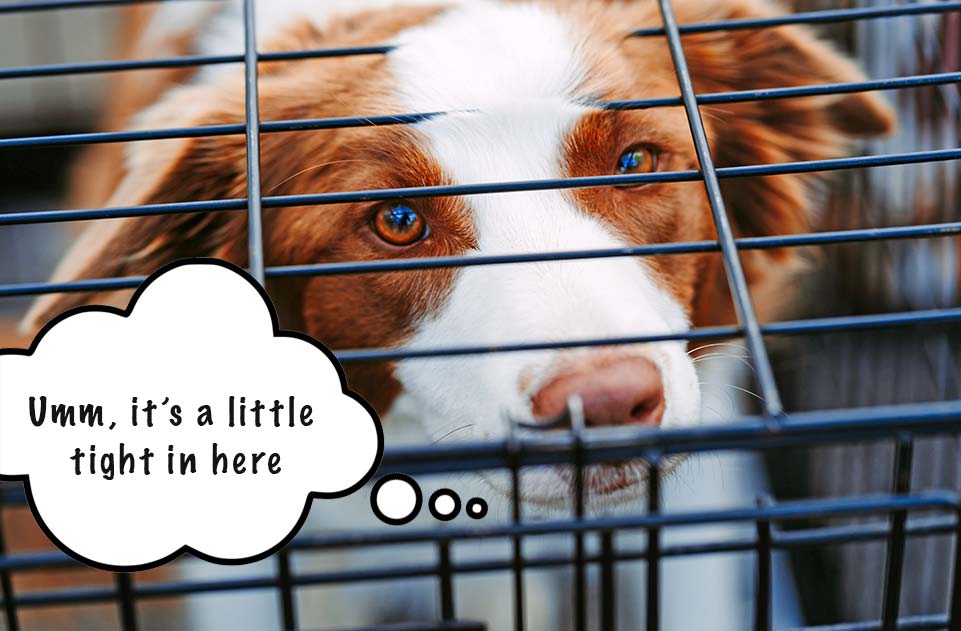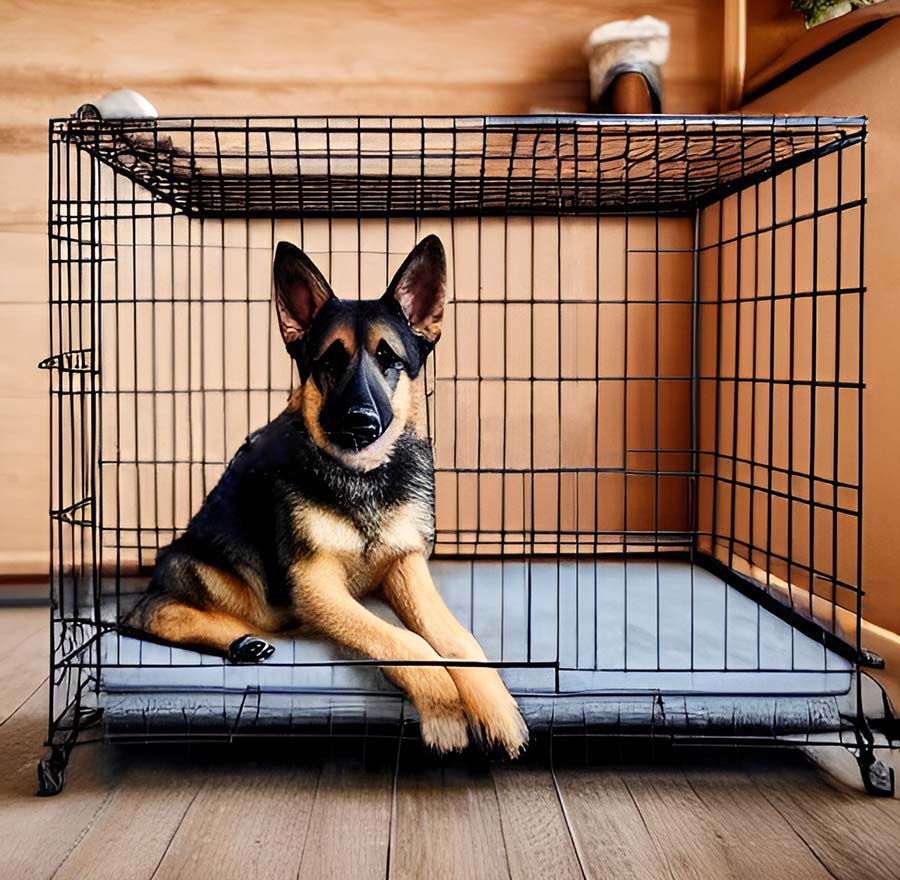
When we went to pick out a crate for our Yorkie, we were originally planning on getting one that was just big enough for him to stand up and turn around in, at least until he got bigger and needed more room. However, the salesperson suggested that we get a bigger crate, and we decided to listen to her advice.
Big mistake! Our dog quickly learned that he could urinate in one corner of the crate and sleep in the other, and he became resistant to using the crate at all. If we had just gotten the size that we originally wanted, we probably would have had much better luck potty training him. (The potty training tips in this article might help you like they did us)
Lesson learned!
When you bring a new furry friend into your home, one of the first pieces of pet furniture you’ll need to purchase is a dog crate. But with all of the different sizes and types of dog crates on the market, it can be tough to know which one is right for your pup. In this blog post, we’ll break down everything you need to know about choosing the right size dog crate for your four-legged friend. Keep reading to learn more!
Table of Contents
- Size Matters (Dog Crate Size – Jeeze!)
- Avoid This Big Mistake When Sizing a Dog Crate
- Weight Based Dog Crate Size Chart
- Crate Types
- How Do I Know If My Dog’s Crate is Too Small?
- Signs Your Dog’s Crate Is Too Small
Size Matters (Dog Crate Size – Jeeze!)
When it comes to choosing a dog crate, size definitely matters. You’ll want to make sure that you choose a crate that’s big enough for your dog to stand up, turn around, and lie down in comfortably. However, you don’t want to choose a crate that’s too big, as this can give your furry friend too much freedom and make it difficult for them to feel safe and secure.
According to the AKC to figure out which size crate is right for your dog, start by measuring them from their nose to the base of their tail. Then, add three to four inches to that number to account for movement. For example, if your dog is 18 inches from nose to tail, you’ll want to purchase a crate no bigger than 22-inches.
Avoid This Big Mistake When Sizing a Dog Crate
You wouldn’t believe how many crate manufacturers and “experts” recommend crates based on your dog’s weight. While you can get a rough idea based on weight it is not an accurate method for choosing the correct dog crate size for your dog.
We have a very burly Yorkie – we call him Thug Muffin because he is very muscled. If we picked a crate based on his weight it would be too big because he is still a typical Yorkie length and height, he’s just big boned.
Weight Based Dog Crate Size Chart
If you can’t find a ruler and just need to be “close enough” here is a weight based size chart for dog crates that we’ve put together based on information from several major dog crate companies.
| Crate Size | Weight of Dog |
| 18″ | 1-10 lbs |
| 24″ | 10-20 lbs |
| 30″ | 20-40 lbs |
| 36″ | 40-60 lbs |
| 42″ | 60-80 lbs |
| 48″ | 80-100 lbs |
| 60″ | 100-150 lbs |
| 72″ | 150+ lbs |
Note: The above chart only gives you a rough idea on what size dog crate you need. If you stick to the tried and true method of measuring your dog from nose to the base of the tail, and floor to top of his head you’ll know the EXACT size crate to get. Just add 3-4 inches to the dimensions and you are good to go.
Crate Types
Now that you know how big a dog crate should be, it’s time to choose the type! There are three main types of crates: wire crates, plastic crates, and soft-sided crates.
Wire crates are generally the most affordable option and are made with metal bars that allow air to flow freely through the crate. However, if you have a vigorous chewer even a metal wire crate will not keep them contained for long.
For more information on choosing the perfect type of crate for your dog that doesn’t like to stay put, check out our blog post on some of our favorite escape proof dog crates.
Plastic crates are also popular among pet parents because they’re easy to clean and offer more privacy than wire crates. Another advantage of a plastic crate is that they are lighter and easier to move from place to place if you need to relocate your crate often.
The third option, soft-sided crates, are even better for dogs who travel often as they’re the lightest of the three and can be easily folded up and transported.
New pet owners often make one of two mistakes when picking out their first dog crate – too big or too small. Guess you saw that coming, there really isn’t another option other than, just right.
Most error on the side of too big thinking they will grow into the crate. But what if your dog gets A LOT bigger than you expected.
You never know if you adopt a stray if one of the parents was a Great Dane or a chihuahua, you know.
Here’s an example from one of our readers:
“We adopted a beautiful, friendly, rescue pup named Sammy. Well, Sammy turned out to get MUCH bigger than we thought he would. I think one of his parents was a horse! He seems uncomfortable in his crate, how do we tell if he needs more room? Or, is his current crate just fine?”

How Do I Know If My Dog’s Crate is Too Small?
If you’ve ever struggled to get your dog to stay in their crate, you’re not alone. It can be tricky to find the perfect size crate for your furry friend, and oftentimes, people end up with a crate that’s too small.
But isn’t it better for your dog to be snug and cozy? Nope. If your dog’s crate is too small, it can actually do more harm than good. Here’s how to tell if your dog’s crate might be too small—and what you can do about it.
Signs Your Dog’s Crate Is Too Small
There are a few key signs that your dog’s crate is too small. If you notice any of the following behavior from your dog when they’re in their crate, it’s time to consider upgrading to a larger size:
1. They Can’t Turn Around Comfortably
One of the clearest signs that your dog’s crate is too small is if they can’t turn around comfortably without bumping into the sides or top of the crate. This can be particularly problematic for taller dogs, who may have trouble standing up straight in a smaller crate. If your dog can’t turn around comfortably, it’s time for a bigger crate.
2. They’re Constantly Trying to Escape
If your dog is constantly trying to escape from their crate, it could be a sign that they’re feeling claustrophobic. When dogs feel like they’re trapped or enclosed in a space, they may start pawing at the sides of the crate, dig excessively, or even try to climb out. If you notice this behavior from your dog, give them some extra space by upgrading to a larger crate.
3. They Seem Uncomfortable or Stressed Out
If your dog seems uncomfortable or stressed out when they are in their crate, it could be because they don’t have enough room to move around and stretch their legs. Dogs need to be able to move around freely in order to feel comfortable, so if yours seems cramped up in their crate, it may be time for an upgrade.
Dogs need the right amount of space to move around and stretch their legs in order to feel comfortable, so if yours seems cramped up in their current crate, it may be time for an upgrade. If you notice any of these signs that your dog crate is too small or too big, don’t hesitate to upgrade to a properly sized crate—your furry friend will thank you for it!









